| Tweet |  |  |
GOOG is trading $575.74, up 0.8% with IV30™ down 2.2%. The Symbol Summary is included below.
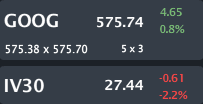
Provided by Livevol
This is an earnings and volatility (risk of earnings) note.
Conclusion
The risk as reflected by the option market in the GOOG stock price is lower now than it has been in any of the prior seven quarters. Further, prior to this event, the last three earnings cycles actually showed continually increasing risk and all of a sudden we see a dramatic drop in that risk for this earnings release.
The two-year stock chart for GOOG (GOOGL) is included below.
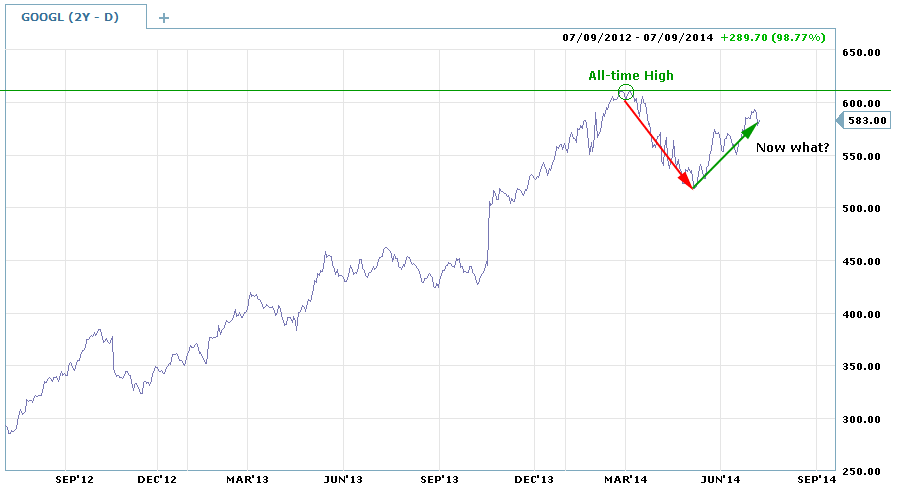
Provided by Charles Schwab optionsXpress
There are really three parts to this chart.
1. A rise of more than 100% in less than two-years to an all-time high above $600.
2. A drop from the all-time high that was abrupt (~10%) but short-lived.
3. The rise from that dip into a range in between the all-time high and the short-term low.
As the chart asks, "what now?" I really wish I could tell you, but I can't... But, I can tell you this...
Let's turn to the IV30™ chart in isolation, below.
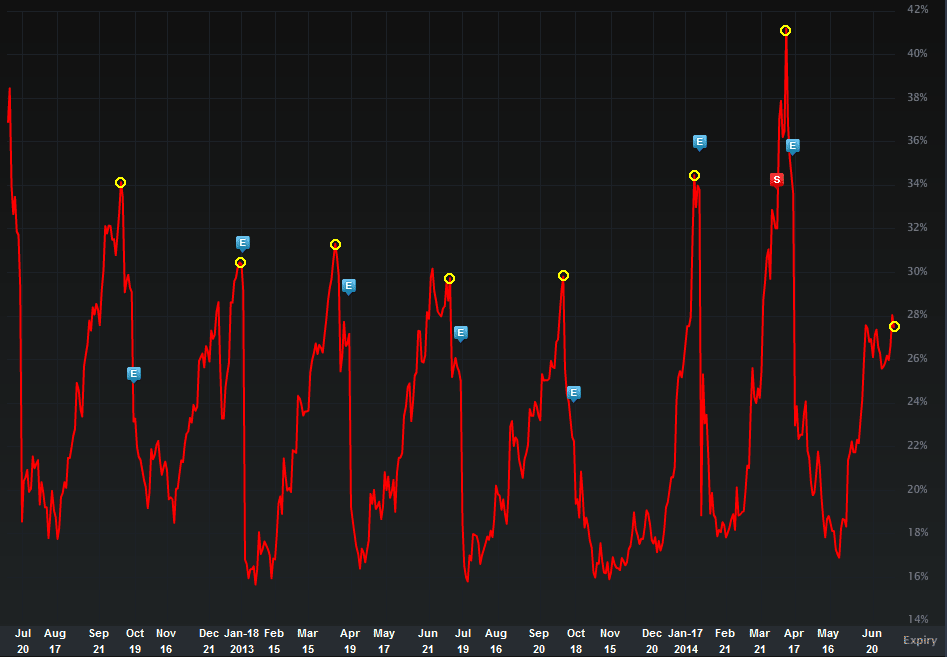
Provided by Livevol
The implied volatility is the forward looking risk in the equity price as reflected by the option market (IV30™ looks forward exactly 30 calendar days).
While the current level of the risk (the red curve) seems right about middle of the road, that is easily deceiving. What we really need to look at is the level of risk relative to the last earnings cycles (the blue E" icons represent earnings).
Let's take the same chart and only focus on the peaks of volatility into (before) earnings events.
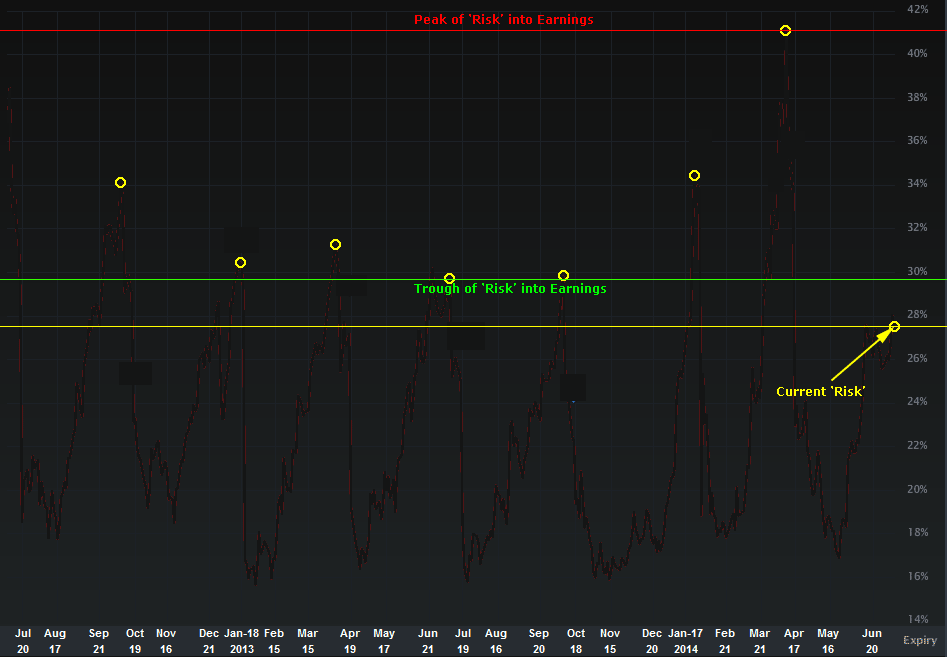
Provided by Livevol
And now we see a totally different story. The implied volatility (the forward looking risk into earnings) is actually below all of the prior earnings releases in this chart.
There is one caveat, which surrounds timing. GOOG isn't set to report earnings until 7-17-2014 after market close. That means we still have a week (ish) before the event. The level of the risk will almost certainly rise as we approach that earnings date, so we are taking a slightly early look.
It's quite possible that the yellow circle (the current risk) will pop back into that range between the green line (lowest risk of the last seven earnings releases) and the red line (the highest risk of the last earnings releases).
But, there's actually something else that caught my eye. Check out when GOOG hit the lows in risk (when the yellow circles are on the green line). Since that time, we have sen the risk into earnings rise massively with each subsequent earnings report.
So, the real question is, why did that happen, and more importantly, why did that trend stop?
The option market's answer is simply:
The risk of large stock moves is lower for this earnings release than it has been for the prior seven and substantially lower than the last two.
Hmm...
The Skew Tab snap (below) illustrates the vols by strike by month.
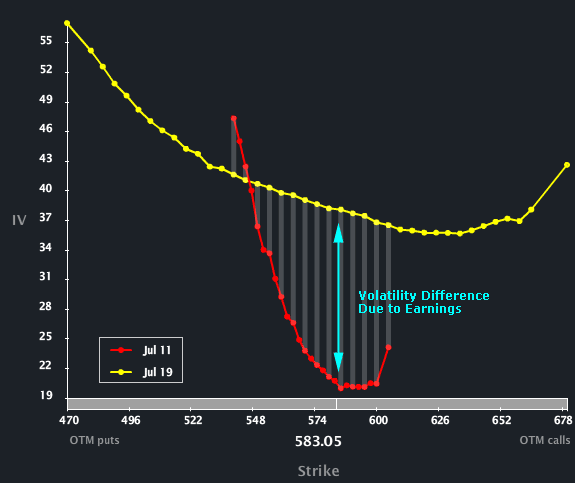
Provided by Livevol
This is just a simple visual to demonstrate how earnings news affects risk. The red curve represents the volatility in the July 11 weekly options (which do not have an earnings event), while the yellow curve represents the July 18th monthly options (which do have earnings). That volatility difference between the two curves is the direct and explicit risk of a large stock move from earnings.
To read more about skew, what is and why it exists you can click the title below:
Understanding Option Skew -- What it is and Why it Exists.
Finally, the Options Tab is included below.
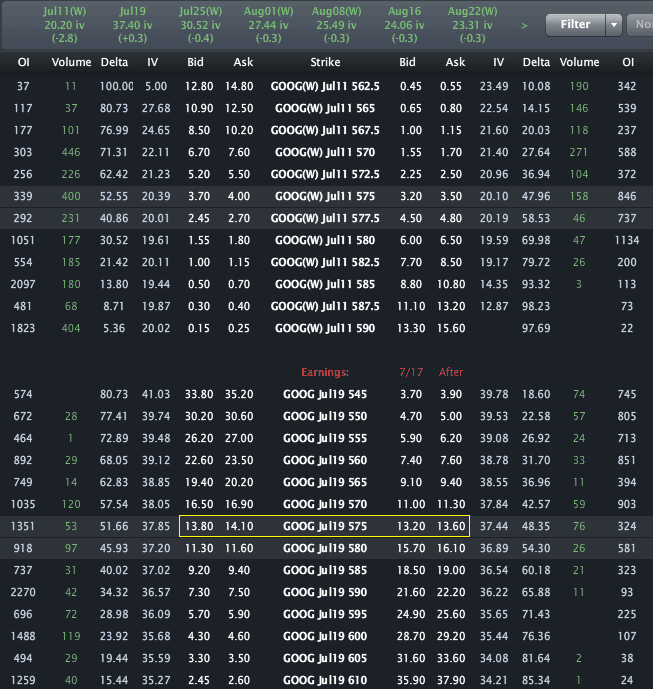
Provided by Livevol
Using the at-the-money (ATM) straddle in the July 18th monthly options we can see that the option market reflects a price range of [$547.50, $602.50].
- If you believe the stock will be outside that range on expiry or any date before then, then you think the volatility is too low.
- If you believe that range is too wide, and that the stock will definitively be in that range on expiration, then you think volatility is too high.
- If you're not sure, and can make an argument for either case, then you think volatility is priced just about right.
This is trade analysis, not a recommendation.
Follow @OphirGottlieb
Tweet
Legal Stuff:
Options involve risk. Prior to buying or selling an option, an investor must receive a copy of Characteristics and Risks of Standardized Options. Investors need a broker to trade options, and must meet suitability requirements.
The information contained on this site is provided for general informational purposes, as a convenience to the readers. The materials are not a substitute for obtaining professional advice from a qualified person, firm or corporation. Consult the appropriate professional advisor for more complete and current information. I am not engaged in rendering any legal or professional services by placing these general informational materials on this website.
I specifically disclaim any liability, whether based in contract, tort, strict liability or otherwise, for any direct, indirect, incidental, consequential, or special damages arising out of or in any way connected with access to or use of the site, even if I have been advised of the possibility of such damages, including liability in connection with mistakes or omissions in, or delays in transmission of, information to or from the user, interruptions in telecommunications connections to the site or viruses.
I make no representations or warranties about the accuracy or completeness of the information contained on this website. Any links provided to other server sites are offered as a matter of convenience and in no way are meant to imply that I endorse, sponsor, promote or am affiliated with the owners of or participants in those sites, or endorse any information contained on those sites, unless expressly stated.



No comments:
Post a Comment